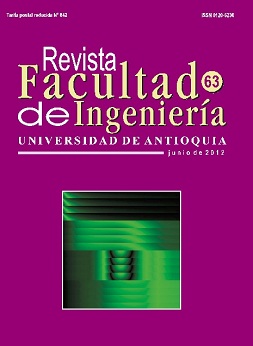Esquema ECV con prevención de fraude usando técnicas de marca de agua
DOI:
https://doi.org/10.17533/udea.redin.12484Palabras clave:
criptografía visual extendido, prevención de fraude, marca de agua, criptografía visualResumen
La Criptografía Visual (CV), propuesta por Naor y Shamir en 1994, es una variación del esquema de secreto compartido convencional. En la CV, en lugar de una llave secreta, se comparte una información visual, tal como una imagen, entre los participantes en una forma de imágenes llamadas sombras. Cada participante posee su propia sombra, de la cual no se puede revelar el secreto, sin embargo realizando la superposición de sombras de participantes calificados, el secreto se puede revelar siendo perceptible por el sistema visual humano. En la CV la superposición de sombras es equivalente al proceso de descifrado, por lo tanto no requiere ninguna carga computacional extra ni ningún conocimiento previo para revelar la imagen secreta. Hasta ahora algunos esquemas importantes de CV, tales como el esquema CV-(k,n), las estructuras de acceso general para CV y el esquema extendido CV (ECV), han sido propuestos. Desafortunadamente todos los esquemas se pueden engañar fácilmente, si uno o algunos participantes tratan de generar sombras falsas para que una imagen falsa se revele como la imagen secreta. En este artículo se propone un esquema de CV que previene este engaño, en el cual la sombra de cada participante se identifica y autentica usando el esquema de ECV y técnicas de marca de agua. En el esquema propuesto la sombra de cada participante se puede identificar por su significado, en lugar de ser una imagen de tipo ruido sin significado, que se usa en un esquema convencional de CV. Para la autenticación de cada sombra, dos imágenes binarias de marca de agua son cifradas usando la operación de corrimiento. Antes de revelar la imagen secreta, la validación de las sombras debe llevarse a cabo, extrayendo ambas imágenes de marca de agua. Si las imágenes de marca de agua extraídas son correctas, la imagen secreta revelada se considera como auténtica, en caso contrario esta se determina como falsa. Los resultados obtenidos por simulación computacional muestran el deseable funcionamiento del esquema propuesto.
Descargas
Citas
M. Naor, A. Shamir. Visual cryptography. Advances in Cryptology-EUROCRYPT’ 94. Ed. Springer-Verlag. 1994. pp. 1-12. DOI: https://doi.org/10.1007/BFb0053419
A. Shamir. “How to Share a Secret”. Communications of the ACM. Vol. 22. 1979. pp. 612-613. DOI: https://doi.org/10.1145/359168.359176
G. Ateniese, C. Blundo, A. De Santis, D. Stinson. “Visual Cryptography for General Access Structures”. Int. J. of Computing. Vol. 129. 1996. pp. 86-106. DOI: https://doi.org/10.1006/inco.1996.0076
G. Ateniese, C. Blundo, A. De Santis, D. Stinson. “Extended Scheme for Visual Cryptography”. Theoretical Computer Science. Vol. 11. 1997. pp. 179- 196.
S. Droste. New Results on Visual Cryptography. Lecture Notes in Computer Science, Advances in Cryptology. Ed. Springer-Verlag. Berlin, Germany. 1996. pp. 401-415. DOI: https://doi.org/10.1007/3-540-68697-5_30
C. Hegde, S. Manus, P. Shenoy, K. Vengopal, L. M. Patnaki. Secure Authentication using Image Processing and Visual Cryptography for Banking Applications. 16th Int. Conf. on Advanced Comp. and Comm. Chennai, India. 2008. pp. 65-72. DOI: https://doi.org/10.1109/ADCOM.2008.4760429
Y. Rao, Y. Sukonkina, C. Bhagwati, U. Singh. Fingerprint based authentication application using visual cryptography methods (Improved ID Card). 2008 IEEE Region 10 Conf. Hyderabad, India. 2008. pp. 1-5. DOI: https://doi.org/10.1109/TENCON.2008.4766425
G. Horng, T. Chen, D-S Tsai. “Cheating in Visual Cryptography”. Designs, Codes and Cryptography. Vol. 38. 2006. pp. 219-236. DOI: https://doi.org/10.1007/s10623-005-6342-0
C-M Hu, W-G Tzeng. “Cheating Prevention in Visual Cryptography”. IEEE Trans. on Image Processing. Vol. 16. 2007. pp. 36-43. DOI: https://doi.org/10.1109/TIP.2006.884916
H. Luo, J. Pan, Z. Lu, B. Liao. Watermarking based Transparency Authentication in Visual Cryptography. 3rd Int. Conf. on Intelligent Information Hiding and Multimedia Signal Processing. Kaohsiung, Taiwan. 2007. pp. 303-306. DOI: https://doi.org/10.1109/ISDA.2007.123
M. Mese, P. Vaidyanathan. “Recent Advances in Digital Halftoning and Inverse Halftoning Methods”. IEEE Trans. on Circuits and Systems-I. Vol. 49. 2002. pp. 790-805. DOI: https://doi.org/10.1109/TCSI.2002.1010034
Descargas
Publicado
Cómo citar
Número
Sección
Licencia
Derechos de autor 2018 Revista Facultad de Ingeniería

Esta obra está bajo una licencia internacional Creative Commons Atribución-NoComercial-CompartirIgual 4.0.
Los artículos disponibles en la Revista Facultad de Ingeniería, Universidad de Antioquia están bajo la licencia Creative Commons Attribution BY-NC-SA 4.0.
Eres libre de:
Compartir — copiar y redistribuir el material en cualquier medio o formato
Adaptar : remezclar, transformar y construir sobre el material.
Bajo los siguientes términos:
Reconocimiento : debe otorgar el crédito correspondiente , proporcionar un enlace a la licencia e indicar si se realizaron cambios . Puede hacerlo de cualquier manera razonable, pero no de ninguna manera que sugiera que el licenciante lo respalda a usted o su uso.
No comercial : no puede utilizar el material con fines comerciales .
Compartir igual : si remezcla, transforma o construye a partir del material, debe distribuir sus contribuciones bajo la misma licencia que el original.
El material publicado por la revista puede ser distribuido, copiado y exhibido por terceros si se dan los respectivos créditos a la revista, sin ningún costo. No se puede obtener ningún beneficio comercial y las obras derivadas tienen que estar bajo los mismos términos de licencia que el trabajo original.










 Twitter
Twitter